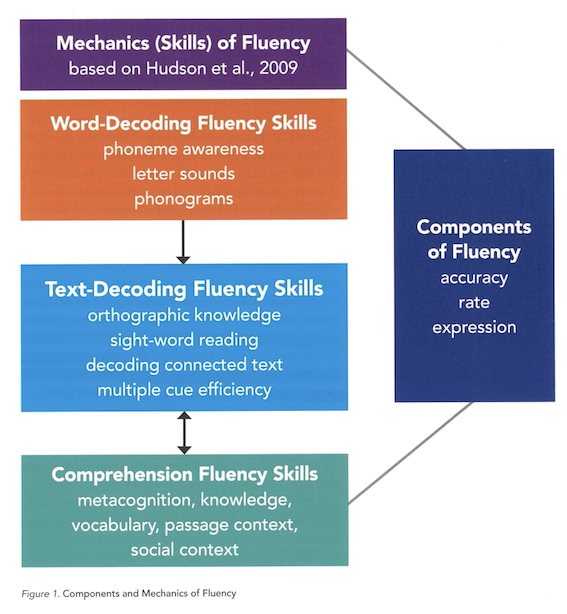Fluency Instruction and Assessment with Jan Hasbrouk
Grades K - 9
Fluent readers have established a firm foundation for reading by integrating the various component skills so well that the act of reading occurs without the reader having to intentionally will the skills into action (Hudson, Pullen, Lane, & Torgesen, 2009 as cited in Reading Fluency, Hasbrouk & Glaser, 2018).
Fluent readers recognize words automatically, without sound-by-sound decoding, allowing them to use more of their cognitive resources to make meaning and monitor understanding as they read. The 2000 US National Reading Panel Report explains, "If the text is read in a laborious and inefficient manner, it will be difficult for the child to remember what has been read and to relate the ideas expressed in the text to his or her background knowledge".
Reading fluency is comprised of many interdependent mechanics, or skills, that work together as shown below (Reading Fluency, Hasbrouk & Glaser, 2018).

Reading fluency can be defined as reasonably accurate reading, at an appropriate rate, with suitable expression, that leads to accurate and deep comprehension and motivation to read. (Hasbrouk & Glaser, 2018). Together accuracy and rate are a measure of word reading automaticity. Being able to recognize words with a minimum of attention, allows the reader to direct most of their attention to comprehension (LaBerge & Samuels, 1974 as cited in Teaching Reading - Fisher & Frey, 2023).
Accuracy: the ability to read words correctly.
Rate: the speed at which a student reads.
Expression: how a reader uses their voice to convey meaning, emotion, and structure of the text.
Slow, inefficient, and disfluent readers need targeted instructional support. These readers will likely have persistent challenges with reading if nothing is done to support their reading progress. Reading fluency is improved through reading practice opportunities including: repeated readings (e.g. choral reading, partner reading) and instructional experiences that further develop automaticity and expressiveness (e.g. Reader's Theatre). It is important to attend to both silent and oral fluency rates throughout the school year to monitor progress (e.g. oral reading fluency (ORF) assessments). (Fisher & Frey, 2023)
Surrey Schools (SD36)
14033 92 Avenue
Surrey, B.C. Canada
V3V 0B7
Phone: 604-596-7733
We are the largest school district in BC and serve Surrey, White Rock and the rural area of Barnston Island.
Copyright © 2025 Surrey School District. Developed by the Surrey Schools Literacy Team. Admin.